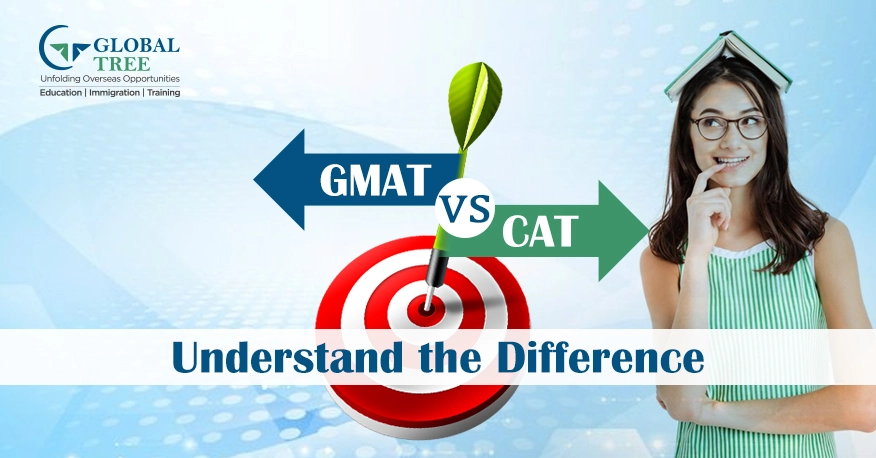GMAT vs. CAT: Understand the Difference

- Introduction
- What is the Difference between CAT and GMAT?
- GMAT vs CAT: Difference between the Overall Pattern
- GMAT vs CAT: Differences in Sections, Numbers, and Types of Questions
- GMAT vs CAT: Eligibility Criteria
- GMAT vs CAT: Syllabus and Marking Scheme
- GMAT Section Wise Exam Pattern
- GMAT vs CAT: Fee Structure
- GMAT vs CAT: Competition and Level of Difficulty
- GMAT vs CAT: Preparation Strategies
- GMAT vs CAT: Score Validity and Retake Policies
- GMAT vs CAT: Admission Process
- Is GMAT Tougher than CAT?
- GMAT vs CAT: The Final Verdict
Introduction
In the world of competitive exams, the GMAT and CAT stand tall as titans, attracting aspiring minds from different corners of the globe.
While CAT (Common Admission Test) is the gateway to prestigious Indian business schools, GMAT (Graduate Management Admission Test) opens doors to international business schools.
So, what sets them apart, and how do you decide which one is the right fit for you? Let's embark on a journey to unravel the differences between GMAT and CAT.
What is the Difference between CAT and GMAT?
CAT and GMAT, both acronyms that sound like members of a secret club, represent two distinct paths in the realm of business education.
CAT is the Indian hero, the key to unlocking the gates of the Indian Institutes of Management (IIMs) and other top-tier B-schools in the country.
On the flip side, GMAT is the global protagonist, offering a ticket to a plethora of international business schools.
GMAT vs CAT: Difference between the Overall Pattern
When it comes to patterns, CAT and GMAT are like Bollywood and Hollywood movies – similar yet distinct.
CAT is a computer-based test that boasts three sections:
Verbal Ability and Reading Comprehension (VARC), Data Interpretation and Logical Reasoning (DI & LR), and Quantitative Ability (QA).
The timing is as crucial as your morning chai – 40 minutes for each section, and the bells ring after 120 minutes.
On the other hand, GMAT throws a mixtape of Analytical Writing Assessment (AWA), Integrated Reasoning (IR), Quantitative, and Verbal sections.
The clock ticks at a different pace here – 75 minutes for Quant, 75 minutes for Verbal, and 30 minutes each for AWA and IR.
It's like trying to choose your next song in the playlist while solving complex math problems – challenging but doable.
GMAT vs CAT: Differences in Sections, Numbers, and Types of Questions
Let's dig a little deeper into the sections.
- CAT prefers the trio – VARC, DI & LR, and QA.
The number of questions in each section fluctuates like the stock market on a volatile day, keeping you on your toes.
A total of 100 questions test your mental agility, and if you conquer them, the golden gates of IIMs swing open.
(Read More: GMAT vs. GRE: which is the right test for you?)
- GMAT, however, likes to keep it concise yet comprehensive.
Quant and Verbal sections each have 31 questions, making a grand total of 62 questions.
AWA and IR sections, though small in number, demand your intellectual prowess. So, while CAT is a marathon, GMAT feels more like a sprint – a sprint through the global landscape of business education.
GMAT vs CAT: Eligibility Criteria
CAT: The eligibility criteria for CAT are pretty straightforward.
A Bachelor's degree with a minimum of 50% marks is your golden ticket.
Oh, and being an Indian citizen or someone belonging to certain categories is also crucial too.
GMAT; being the global nomad, doesn't discriminate based on your geographical roots. Anyone with a bachelor's degree can take the test, irrespective of nationality.
As long as you have the qualifications, you're welcome to join the GMAT.
GMAT vs CAT: Syllabus and Marking Scheme
Now, let's talk about the CAT and GMAT syllabus – the roadmap to success in the exams.
CAT revolves around concepts in mathematics, data interpretation, logical reasoning, and English language skills.
The marking scheme is a blend of correctness, time management, and strategic guessing – a chess game where every move counts.
GMAT covers similar ground with quantitative and verbal sections. The twist lies in the Integrated Reasoning section, testing your ability to analyze data in various formats.
As for the AWA section in the GMAT exam, it's like an essay competition, where coherence and clarity win the day. Marking in GMAT is not just about getting answers right; it's about showcasing a holistic skill set.
GMAT Section Wise Exam Pattern
Let's break down the GMAT sectional wise:
Analytical Writing Assessment (AWA):
Task: Write an essay analyzing an argument.
Time: 30 minutes.
Integrated Reasoning (IR):
Types of Questions: Graphics interpretation, table analysis, multi-source reasoning, two-part analysis.
Time: 30 minutes.
Quantitative:
Types of Questions: Data sufficiency, problem-solving.
Time: 75 minutes.
Verbal:
Types of Questions: Reading comprehension, critical reasoning, sentence correction.
Time: 75 minutes.
GMAT is diverse – from essay writing to interpreting complex data
GMAT vs CAT: Fee Structure
Money matters, and so does the cost of the exam.
CAT, being the local star, charges a nominal fee, making it accessible to a wide range of students. It's reasonable.
On the other hand, GMAT, the international sensation, comes with a relatively higher price tag.
The fee reflects the global stature of the exam, offering a passport to business schools around the world.
It's an investment in your global career.
(Read More: Top Colleges to study MBA in Canada)
GMAT vs CAT: Competition and Level of Difficulty
CAT is the battle royale of Indian B-school admissions, with lakhs of students vying for a limited number of seats.
The competition is fierce, like a cricket match where every run is hard-earned.
It is challenging but achievable with the right strategy.
Now, let's hop onto the global stage with GMAT. The competition here is no less intense, with aspirants from every corner of the world competing for a spot in renowned international business schools.
The difficulty level is demanding, but the view from the top is worth the effort.
GMAT vs CAT: Preparation Strategies
Preparing for CAT is like training for a marathon – consistent, focused, and tailored to the Indian business landscape.
Conceptual clarity, time management, and mock tests become your best friends.
practice makes perfect.
On the flip side, GMAT preparation is a global expedition. Along with mastering core concepts, you need to hone your analytical and critical thinking skills. The AWA section demands your essay-writing finesse, and IR requires a knack for data interpretation.
GMAT vs CAT: Score Validity and Retake Policies
CAT scores are valid for one year, making it a time-bound race. If you're not satisfied with your score or want to improve, you need to wait for the next CAT season.
On the other hand, GMAT scores are valid for five years, offering a more extended window of opportunity. If you decide to retake the exam for a better score or explore new educational avenues, you have the flexibility to do so.
GMAT vs CAT: Admission Process
CAT opens the doors to the IIMs and other prestigious Indian B-schools. The admission process involves written ability tests, group discussions, and personal interviews.
In the case of GMAT, the admission process varies across international business schools. Some may require only your GMAT score, while others might include interviews, essays, and recommendation letters.
(Read More: Is GMAT coaching necessary to score high on the exam?)
Is GMAT Tougher than CAT?
The million-dollar question – is GMAT tougher than CAT?
Well, it's like comparing apples and oranges. CAT is an intense, fast-paced challenge tailored for Indian B-schools, while GMAT is a global expedition that demands a different set of skills.
If CAT is a sprint, GMAT is a marathon, and the difficulty lies in the eye of the beholder.
This also means both are achievable with sheer effort and planning with your goals in mind
GMAT vs CAT: The Final Verdict
In the end, the choice between GMAT and CAT depends on your career aspirations and the destinations you dream of.
If your goal is to conquer the Indian business landscape, CAT is your trusty steed. On the other hand, if you yearn for international exposure and dream of studying in renowned global institutions, GMAT is your magic carpet.
So, whether you choose CAT or GMAT, remember that both paths lead to exciting opportunities and promising careers. It's not about which exam is better; it's about which one aligns with your dreams and ambitions.
(Read More: Benefits of taking GMAT Test Preparation classes)
In this articulated dance-off between CAT and GMAT, may you find what resonates with your aspirations and leads you to success.
Remember,
You're the star of your unique show.









